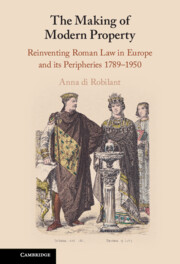17 results
Dedication
-
- Book:
- The Making of Modern Property
- Published online:
- 13 July 2023
- Print publication:
- 27 July 2023, pp v-vi
-
- Chapter
- Export citation
2 - The Foundations of Romanist-Bourgeois Property
-
- Book:
- The Making of Modern Property
- Published online:
- 13 July 2023
- Print publication:
- 27 July 2023, pp 98-130
-
- Chapter
- Export citation
Acknowledgments
-
- Book:
- The Making of Modern Property
- Published online:
- 13 July 2023
- Print publication:
- 27 July 2023, pp viii-x
-
- Chapter
- Export citation
Index
-
- Book:
- The Making of Modern Property
- Published online:
- 13 July 2023
- Print publication:
- 27 July 2023, pp 355-370
-
- Chapter
- Export citation
7 - The Social Critics
-
- Book:
- The Making of Modern Property
- Published online:
- 13 July 2023
- Print publication:
- 27 July 2023, pp 280-321
-
- Chapter
- Export citation
3 - Crafting Romanist-Bourgeois Property
-
- Book:
- The Making of Modern Property
- Published online:
- 13 July 2023
- Print publication:
- 27 July 2023, pp 131-166
-
- Chapter
- Export citation
Copyright page
-
- Book:
- The Making of Modern Property
- Published online:
- 13 July 2023
- Print publication:
- 27 July 2023, pp iv-iv
-
- Chapter
- Export citation
5 - The Tensions of Absolute Property
-
- Book:
- The Making of Modern Property
- Published online:
- 13 July 2023
- Print publication:
- 27 July 2023, pp 204-234
-
- Chapter
- Export citation
4 - Reform, Not Revolution
-
- Book:
- The Making of Modern Property
- Published online:
- 13 July 2023
- Print publication:
- 27 July 2023, pp 167-203
-
- Chapter
- Export citation
6 - Roman Dominium in the Republics of Latin America
-
- Book:
- The Making of Modern Property
- Published online:
- 13 July 2023
- Print publication:
- 27 July 2023, pp 235-279
-
- Chapter
- Export citation
Conclusions
-
- Book:
- The Making of Modern Property
- Published online:
- 13 July 2023
- Print publication:
- 27 July 2023, pp 322-326
-
- Chapter
- Export citation
1 - What Roman Antiquity Had to Offer
-
- Book:
- The Making of Modern Property
- Published online:
- 13 July 2023
- Print publication:
- 27 July 2023, pp 39-97
-
- Chapter
- Export citation
Introduction
-
- Book:
- The Making of Modern Property
- Published online:
- 13 July 2023
- Print publication:
- 27 July 2023, pp 1-38
-
- Chapter
- Export citation
References
-
- Book:
- The Making of Modern Property
- Published online:
- 13 July 2023
- Print publication:
- 27 July 2023, pp 327-354
-
- Chapter
- Export citation
Contents
-
- Book:
- The Making of Modern Property
- Published online:
- 13 July 2023
- Print publication:
- 27 July 2023, pp vii-vii
-
- Chapter
- Export citation

The Making of Modern Property
- Reinventing Roman Law in Europe and its Peripheries 1789–1950
-
- Published online:
- 13 July 2023
- Print publication:
- 27 July 2023
5 - Property’s Building Blocks: Hohfeld in Europe and Beyond
- from Part II - Hohfeld and Property
-
-
- Book:
- Wesley Hohfeld A Century Later
- Published online:
- 14 July 2022
- Print publication:
- 28 July 2022, pp 223-257
-
- Chapter
- Export citation



